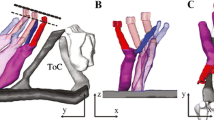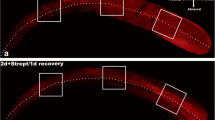Abstract
Motile properties of outer hair cells (OHCs) may contribute to sharp tuning and amplification in the mammalian cochlea. Shape changes of isolated OHCs in response to various physical and chemical influences have been investigated intensively. However, determinations of shape may have been influenced by unanticipated effects of preparation and preservation of the OHCs investigated. Thus, in a first step, lengths of freshly isolated OHCs from the guinea pig cochlea were determined using a video-enhancing magnification system. The cuticular plate/cell axis angle (CP/CA angle) was then measured in native cells and under the influence of potassium chloride and potassium gluconate incubation. To show the influence of glutaraldehyde (GA) fixation on the isolated OHCs, fixative dependent changes on cell length and CP/CA angle were recorded in native and preincubated OHCs. In these experiments, the cell length of vital isolated OHCs was between 41.5 μm, in the basal turn, and 103.7 μm, in the apical turn. The average CP/CA angle was 106° ± 4.2° (n = 324 cells, turns 1–4) with no statistically significant differences for the four turns. Under the influence of potassium chloride, cell length was reduced by 8.1%. Potassium gluconate incubation led to a shortening of cell length, followed by a 5.3% increase after 5 min. The CP/CA angle under potassium chloride was decreased (97.0°) and was then increased under the influence of potassium gluconate (110.7°) as a result of cuticular plate tilting. Cell shrinkage after fixation depended on the fixative's osmolarity and on the GA concentration. Increased GA levels amplified cell shrinkage from 34% for hypo-osmolar solutions to 15% in iso-osmolar and 29% in hyperosmolar solutions. The CP/CA angle of native and incubated OHCs was not different from those fixed with GA. The present data provide a rational basis for isolated OHC shape parameters. Moreover, functionally induced changes can be better interpreted when OHCs are influenced by fixatives, as shown in the GA experiments.
Similar content being viewed by others
References
Anniko M, Lim R, Wrolewski R (1984) Elemental composition of individual cells and tissues in the cochlea. Acta Otolaryngol (Stockh) 98:439–453
Arnold W, Anniko M (1989) Supporting and membrane structures of outer hair cells: evidence for an isometric contraction. ORL (Basel) 51:339–353
Ashmore JF (1987) A fast motile response in guinea pig outer hair cells: the cellular basis of the cochlear amplifier. J Physiol (Lond) 388:323–347
Balle VH (1990) Clinical experience with early post-mortem human inner ear perfusion. Acta Otolaryngol (Stockh) [Suppl] 470:28–30
Brownell WE, Bader CR, Bertrand D, de Ribeaupierre Y (1985) Evoked mechanical responses of isolated cochlear outer hair cells. Science 227:194–196
Brundin L, Flock A, Canlon B (1989) Sound induced motility of cochlear hair cells is frequency specific. Nature 342:814–816
Canlon B, Brundin L, Flock A (1988) Acoustic stimulation causes tonotopic alterations in the length of isolated outer hair cells from the guinea pig hearing organ. Proc Natl Acad Sci USA 85:7033–7035
Cecola RP, Bobbin RP (1992) Lowering extracellular chloride concentration alters outer hair cell shape. Hear Res 61:65–72
Crawford GNC, Barer R (1951) The action of formaldehyde on living cells as studied by phase-contrast microscopy. Quart J Microsc Sci 92:403–452
Dodson HC, Walliker JR, Bannister LH, Douek EE, Fourcin AJ (1987) Structural effects of short term and chronic extracochlear electrical stimulation on the guinea pig spiral organ. Hear Res 31:65–78
Dulon D, Aran JM, Schacht J (1987) Osmotically induced motility of outer hair cells: implications for Menière's disease. Arch Otorhinolaryngol 244:104–107
Engström B, Hillerdal M, Hillerdal G (1990) Preservation of the human cochlea with two different fixatives. Acta Otolaryngol (Stockh) [Suppl] 470:31–33
Ernst A, Reuter G, Zimmermann U, Zenner HP (1994) Acute gentamicin ototoxicity in cochlear outer hair cells of the guinea pig. Brain Res 636: 153–156
Gitter AH (1992) The length of isolated outer hair cells is temperature dependent. ORL J Otorhinolaryngol Relat Spec 54: 121–123
Gitter AH, Zenner HP (1990) The cell potential of isolated inner hair cells in vitro. Hear Res 45:87–94
Gitter AH, Zenner HP, Frömter E (1986) Membrane potential and ion channels in isolated outer hair cells of the guinea pig cochlea. ORL J Otorhinolaryngol Relat Spec 48:68–75
Hopwood D (1972) Theoretical and practical aspects of glutaraldehyde fixation. Histochem J 4:467–303
Hopwood D (1977) Fixation and fixatives. In: Bancroft JD, Stevens A (eds) Theory and practice of histological techniques. Churchill Livingstone, New York, p 17
Kelly JP (1989) Morphometry of the apical turn of the guinea p2 s cochlea. Acta Otolaryngol (Stockh) [Suppl] 103:113–122
Lim DJ, Flock A (1985) Ultrastructural morphology of enzyme-dissociated cochlear sensory cells. Acta Otolaryngol (Stockh) 99:478–492
Reuter G, Zenner HP (1990) Active radial and transverse motile responses of outer hair cells in the organ of corti. Hear Res 45: 219–230
Reuter G, Gitter AH, Thurm U, Zenner HP (1992) High frequency movements of the reticular lamina induced by outer hair cell motility. Hear Res 60:236–246
Schacht J, Zenner HP (1986) The phosphoinositide cascade in isolated outer hair cells: possible role as second messenger for motile responses. Hear Res 22:94
Slepecky N, Chamberlain SC (1986) Immunoelectron microscopic and immunofluorescent localization of cytoskeletal and muscle-like contractile proteins in inner ear sensory hair cells. Hear Res 20:245–260
Slepecky N, Ulfendahl M (1988) Glutaraldehyde induces cell shape changes in isolated outer hair cells from the inner ear. J Submicrosc Cytol Pathol 20:37–45
Slepecky N, Ulfendahl M, Flock A (1988) Effects of caffeine and tetracaine on outer hair cell shortening suggest intracellular calcium involvement. Hear Res 32:11–32
Slepecky N, Ulfendahl M, Flock A (1988) Shortening and elongation of isolated outer hair cells in response to application of potassium gluconate, acetylcholine and cationized ferritin. Hear Res 34:119–126
Thalmann R, Thalmann I, Comegys ZH (1972) Quantitative biochemistry of the organ of corti. Laryngoscope 82:2059–2078
Ulfendahl M (1988) Volume and length changes in outer hair cells of the guinea pig after potassium-induced shortening. Arch Otorhinolaryngol 245:237–243
Zajic G, Schacht J (1987) Comparison of isolated outer hair cells from five mammalian species. Hear Res 26:249–256
Zenner HP (1986) Motile responses in outer hair cells. Hear Res 22:83–90
Zenner HP (1988) Motility of outer hair cells as an active, actin mediated process. Acta Otolaryngol (Stockh) 105:39–44
Zenner HP, Gitter AH, Zimmermann U, Schmitt U, Frömter E (1985) Die isolierte lebende Haarzelle. Laryngorhinootologie 64:642–648
Zenner HP, Zimmermann U, Gitter AH (1987) Fast motility of isolated mammalian auditory sensory cells. Biochem Biophys Res Commun 149:304–308
Zenner HP, Arnold W, Gitter AH (1988) Outer hair cells as fast and slow cochlear amplifiers with a bidirectional transduction cycle. Acta Otolaryngol (Stockh) 105:457–462
Zenner HP, Zimmermann R, Gitter AH (1988) Active movements of the cuticular plate induce sensory hair motion in mammalian outer hair cells. Hear Res 34:233–240
Zenner HP, Gitter AH, Rudert M, Ernst A (1992) Stiffness, compliance, elasticity and force generation of outer hair cells. Acta Otolaryngol (Stockh) 112:248–253
Author information
Authors and Affiliations
Rights and permissions
About this article
Cite this article
Kempf, H.G., Zimmermann, U. & Zenner, H.P. Preservation of the non-rectangular cuticular plate/cell axis angle of outer hair cells. Eur Arch Otorhinolaryngol 253, 5–10 (1996). https://doi.org/10.1007/BF00176694
Received:
Accepted:
Issue Date:
DOI: https://doi.org/10.1007/BF00176694




